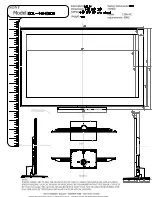
130
Operation in Normal Operating
Mode
• Power switch On/Off
• Input switchover
• Changing of screen size
• Volume adjustment
• Setting of KEY LOCK/UNLOCK
Adjustments and settings in
menu mode
Adjustments and settings in
Integrator mode
Adjustments and settings in
RS-232C adjustment mode
• Approximately four seconds after the end of the operation
• When entering the STANDBY status through remote operation, through the operating panel
of the main unit, or by issuing a <POF> command.
• When switched to Menu mode as a result of a MENU button action
• When switched to RS-232C adjustment mode by an <AJY> command
(NOTE) Among the RS-232C commands available in Normal Operating mode, some are not stored in
last memory when used in this mode.
See 5.5.1, “About the RS-232C Adjustment Mode”.
• Approximately four seconds after the end of the operation
• When entering the STANDBY status through remote operation, through the operating panel
of the main unit, or by issuing a <POF> command
• When returning to the previous screen with the SET button
• When exiting Menu mode with the MENU button (restoring the unit to Normal Operating
mode)
• When exiting Menu mode with the KEY LOCK/UNLOCK button (switching unit to Normal
Operating mode and entering the KEY LOCK status)
• When switching to RS-232C adjustment mode with an <AJY> command
• When automatically exiting Menu mode after persistence of no-signal status for approximately
eight minutes (restoring the unit to Normal operating mode)
• Approximately four seconds after the end of the operation
• When entering the STANDBY status through remote operation, through the operating panel
of the main unit, or by issuing a <POF> command
• When returning to the previous screen with the SET button
• When exiting Integrator mode with the MENU button (restoring the unit to Normal Operating
mode)
• When exiting Integrator mode with the KEY LOCK/UNLOCK button (switching unit to Normal
Operating mode and entering the KEY LOCK status)
• When switching to RS-232C adjustment mode with an <AJY> command
• When automatically exiting Integrator mode after persistence of no-signal status for
approximately eight minutes (restoring the unit to Normal operating mode)
• Approximately four seconds after the end of the operation
• When entering the STANDBY status through remote operation, through the operating panel
of the main unit, or by issuing a <POF> command
• When changing adjustment or setting items using PC commands
• When exiting the RS-232C adjustment mode with an <AJY> command (restoring the unit to
Normal Operating mode)
• When exiting RS-232C adjustment mode with the KEY LOCK/UNLOCK button (switching
unit to Normal Operating mode and entering the KEY LOCK or KEY/UNLOCK status)
• When exiting the RS-232C mode with the MENU button (restoring the unit to Normal
operating mode)
Item
Memory Timing
(NOTE) If you start or stop the entire system by switching a breaker on or off, allow enough time for the last memory
function to be performed by satisfying the timing requirements given above.
Note that this practice causes count errors on the hour meter.
5.1.6 Aging
After switching on power to the unit, input signals to perform aging until the unit stabilizes. Use signals that are unlikely
to cause the displayed images to be “burned” onto the screen: signals such as a 100 % white signal, or animation from
LDs are recommended. The process should take about 30 minutes. This ensures precision adjustments.
(NOTE) Display of still images over extended periods can lead to the above-mentioned “burning”.
5.1.5 Last Memory
The last memory timing used by the unit is given in the table below.
Remember, no last memory function is executed if you perform the following without meeting these timing requirements:
• Switch off MAIN POWER;
• Unplug the power;
• Switch off the outlet.
Before Beginning Adjustments
















































